Bangladesh and northeast India are experiencing one of the worst floods in decades due to incessant rains from upstream regions since the middle of this month…writes Mahua Venkatesh
Rice imports in flood-hit Bangladesh will rise in the coming months. Sources said that several private importers have already placed orders with Indian rice exporters. “These are not government to government deals but mostly in the private sector domain,” a person with direct knowledge told India Narrative.
According to All India Rice Exporters’ Association, in 2020-21, Bangladesh imported 4,91,000 tonne of rice from India. In 2021-22 the amount increased to 9,14,000 tonne.
At a time when the Russia-Ukraine war has already pushed global food prices, these severe floods could trigger food insecurity too in Bangladesh as large qualities of household stocks, especially in the rural areas have also got washed away in the flood.
Bangladesh and northeast India are experiencing one of the worst floods in decades due to incessant rains from upstream regions since the middle of this month.

“The floods will now add to the pressure and all the gains that Bangladesh made in strengthening its food security are now eroding,” a trade analyst dealing in South Asian studies told India Narrative.
Bangladesh is home to 165 million, of whom 38 per cent are engaged in the agricultural and fisheries sector.
As the Russia-Ukraine crisis continues to disrupt the global trade of key foods such as wheat and vegetable oils, along with fertilisers, impacts are falling heavily on countries such as Bangladesh. “Dependent on imports of those items to feed its large population, many poor and vulnerable to shocks, the country faces the prospect of rising food insecurity,” the International Food Policy Research Institute (IFPRI) said.
“Large crops have been damaged in Bangladesh and this will increase import demand from India. Our exporters are ready to supply as we have stocks which are more than sufficient. There is no question of banning exports,” Vinod Kaul, Senior Executive Director, All India Rice Exporters’ Association, told India Narrative.
About 56,000 hectare of paddy crops in Sylhet alone have been damaged. Sylhet, which is home to Boro rice cultivation, is one of the worst affected areas. Several types of rice are grown in Bangladesh, the main being Aus, Aman and Boro.
The grain yield for Boro rice is about 4,950 kg per hectare.
Kaul added that the sowing season for rice has just commenced. “Indications are that sowing will be carried out normally this year with expectation of a more or less normal monsoon,” he said.
Bangladesh is one of the major rice producing countries in the world but its imports of the grain, which is a symbol of wealth in the South Asian nation, has been rising for the last few years, to keep pace with the increased demand.
Last week, the Sheikh Hasina government slashed the import duty of rice from 62.5 to 25 per cent on rice to boost inbound shipment of the grain. The new rate will be applicable till October 31.
Even though Bangladesh is the third-biggest rice producer in the world with 35 million tonne a year, it depends on imports from other countries to deal with shortages caused by natural disasters like floods and drought, Maritime Gateway, a publication focused on shipping and logistics industry, said in a report.
Besides India, Bangladesh imports rice from Vietnam, Pakistan, Philippines and China among other countries.
(The content is being carried under an arrangement with indianarrative.com)














